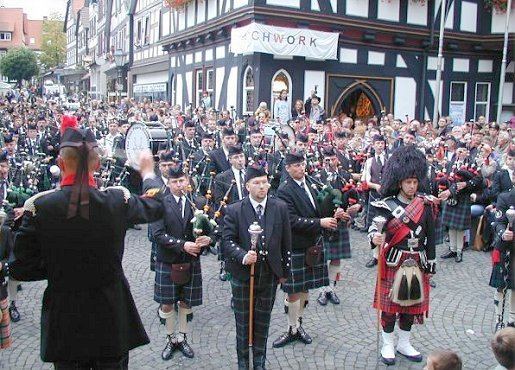Admin. region Gießen Elevation 330 m (1,080 ft) Population 10,974 (30 Jun 2009) | District Vogelsbergkreis Time zone CET/CEST (UTC+1/+2) Local time Friday 2:24 PM | |
 | ||
Weather 11°C, Wind NE at 14 km/h, 67% Humidity Points of interest Hoherodskopf, Vogelsberg Mountains, Vogelpark Schotten, Baumkronenpfad Hoherodskopf, Taufstein | ||
Schotten is a town in the middle of Hesse, Germany. Larger towns nearby include Alsfeld in the north, Fulda in the east, Friedberg in the south and Gießen in the west.
Contents
- Map of Schotten Germany
- Location
- Neighbouring communities
- Constituent communities
- History
- Municipal area development
- Coat of arms
- Town partnerships
- Transport
- Sports and leisure
- Buildings
- Regular events
- Sons and daughters of the town
- References
Map of Schotten, Germany
Location
The officially recognised climatic spa lies between 168 m and 773 m above sea level on the western slope of the Vogelsberg Mountains. Nearby are Hoherodskopf (764 m) and Taufstein (773 m), the two highest peaks in the High Vogelsberg Nature Park. Schotten is a tourist town thanks to reliably high snowfall in the winter and hiking opportunities in the summer in the extensive forests. Watersports are also possible on the Nidda Reservoir.
In the outermost northwestern municipal area is the source of the river Nidda, a favourite destination for hikers.
Neighbouring communities
Schotten borders in the north on the town of Ulrichstein, in the northeast on the town of Herbstein, in the east on the community of Grebenhain, in the south on the town of Gedern and the community of Hirzenhain (both in the Wetteraukreis), and in the west on the town of Nidda (Wetteraukreis) and the town of Laubach (district).
Constituent communities
Besides the main town, which bears the same name as the whole municipality, Schotten is divided into the following communities: Betzenrod, Breungeshain, Burkhards, Busenborn, Eichelsachsen, Einartshausen, Eschenrod, Götzen, Kaulstoß, Michelbach, Rainrod, Rudingshain, Sichenhausen and Wingershausen.
History
Archaeological finds from the Schotten area reach back to the New Stone Age. Several barrows bear witness to prehistoric times as do the "Alteburg" and "Wildhauskopf" ringwalls, whose building date is unknown.
Schotten had its first documentary mention in 778. The "Horstburg", a local castle near the constituent community of Rudingshain, may have stood in connection with the town's founding. There were digs at the ruins in the 1970s, and they were interpreted as having been a Carolingian royal court. Schotten is said to have been founded by Irish-Scottish monks. The great Gothic Liebfrauenkirche ("Church of Our Lady") was built in the 14th century.
In the Middle Ages, Schotten belonged to the Eppstein and Trimberg noble families. The Rhenish League of Towns, in a feud with these families, captured the town and destroyed the walls and the stately home. From 1403, Schotten belonged to the Hessian Landgraves. The current stately home, the Schottener Schloss, dates from this time.
Municipal area development
Under the municipal reforms in the early 1970s, 15 communities were amalgamated into a greater community of Schotten.
Coat of arms
Schotten's civic coat of arms might heraldically be described thus: In azure a falcon argent armed gules wings outstretched standing upon a hill. Or, the golden hill stands for the Vogelsberg Mountains. The falcon comes from a legend about the town's founding.
Town partnerships
Schotten has the following partner towns:
other partner towns include:
Transport
Federal Highways (Bundesstraßen) B 455 and B 276 run through the town. The nearest Autobahnen are the A 5 and the A 45.
The B 276 from Gedern by way of Schotten to Laubach is a notorious motorcycle road that attracts motorcyclists in droves on sunny weekends, not least of all for the motorcycle clubs along the road, such as the Falltorhaus ("Portcullis House"). There have been problems with street racing, which in 2005 left 12 people dead and another 129 injured. A particular problem on the highway is the "Applauskurve", a 180° bend in the road between Schotten and Laubach, known to motorcyclists all over Germany. There, onlookers – mostly other motorcyclists – gather to watch motorcycles take the curve at great speed, applauding – and even photographing or filming – the ones who go round the bend with the greatest lean.
Sports and leisure
Schotten is also home to the Niddastausee, a man-made lake. Here, sailors, surfers and other watersport lovers find a place, as do recreation seekers. In winter, on the other hand, the Hoherodskopf is probably the favourite outing destination in the area.
Buildings
In the Old Town, the Gothic Liebfrauenkirche can be seen with its famous Marienaltar. The winged altar was made about 1385 by an unknown painter.
Regular events
In motorsport, the town is known for the Schottenring races.
